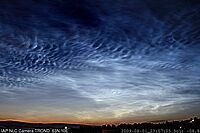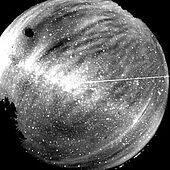Gravity waves in winds, temperatures, and trace gases
Gravity waves are periodic oscillations of temperature, air density, pressure, und wind. They are observed in the whole middle atmosphere. The periods of these oscillations are between a few minutes and several hours, horizontal wave lengths range from 10 km to some thousands of kilometers, and vertical wavelenghts from a few kilometers to 30 km. Gravity waves are generated, among others, by orography, at strong convection cells (e.g., like thunder storms), or at the jet stream in the tropopause region.
Gravity waves are an important driver on the atmospheric circulation. They transport energy and momentum from the place of their generation upward to the middle atmosphere where they break. There, energy and momentum are transfered to the background atmosphere. In this manner gravity waves drive the residual circulation. This circulation from the summer pole to the winter pole is the reason for the cold summer mesopause.
Gravity waves in wind and temperatur data and in noctilucent clouds (NLC) are studied by lidar measurements. Wind measurements above Andenes allow for the first time to derive the potential and the kinetic gravity-wave energy simultaneously. Since temperatures of the mesosphere above Kühlungsborn and Andenes are measured since several years, seasonal variations of the wave activity can be studied.
While the temporal resolution of these data is mostly about one hour, the strong backscatter signal from NLC allows the observation of short-periodic gravity waves.
The two-dimensional structure of gravity waves in airglow (OH layer at about 87 km) is observed by special cameras. The deduced temperatures are compared to vertical temperature profiles derived by lidar.
Selected publications
- I. Strelnikova, M. Almowafy, G. Baumgarten, K. Baumgarten, M. Ern, M. Gerding and F.-J. Lübken, Seasonal cycle of gravity wave potential energy density from lidar and satellite observations at 54° and 69°N, J. Atmos. Sci., 78, 1359-1386, doi:10.1175/JAS-D-20-0247.1, 2021.
- I. Strelnikova, G. Baumgarten and F.-J. Lübken, Advanced hodograph-based analysis technique to derive gravity-waves parameters from lidar observations, Atmos. Meas. Tech., 13, 479-499, doi:10.5194/amt-13-479-2020, 2020.
- K. Baumgarten, M. Gerding, G. Baumgarten und F.-J. Lübken, Temporal variability of tidal and gravity waves during a record long 10 day continuous lidar sounding, Atmos. Chem. Phys., 18, 371-384, doi:10.5194/acp-18-371-2018, 2018.














